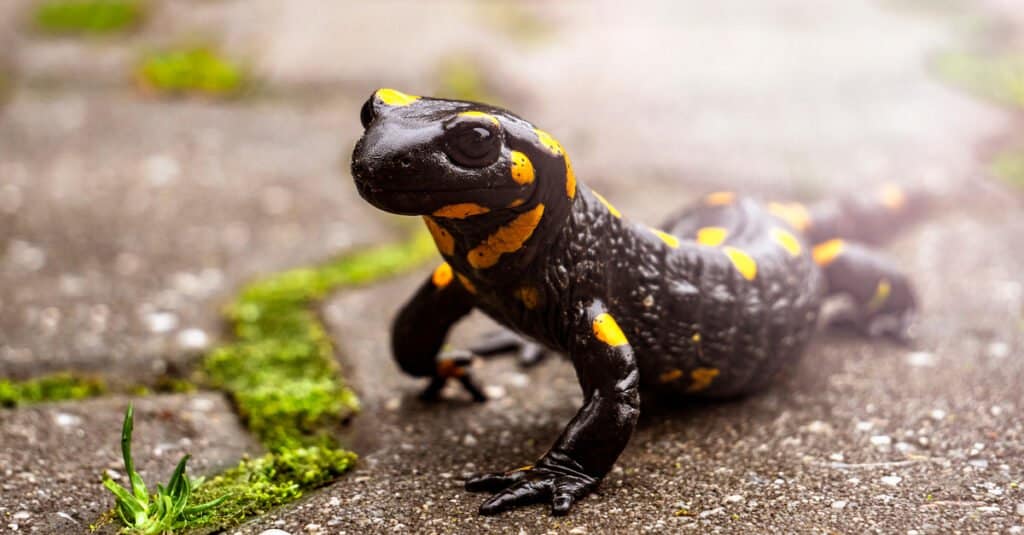Salamanders are ideal for people who are intrigued by colorful, lively amphibians. Salamanders and newts are among the most popular exotic pets for good reason. They’re striking to look at and fun to watch. Like any pet, however, they need the right care and feeding if they are going to thrive.
Before Buying a Salamander
Salamanders are beautiful creatures, and they can be wonderful to watch. A salamander requires some initial upfront costs, including a tank, accessories, and food. You’ll need a large tank, and you must find a veterinarian who specializes in exotic pets.
Over time, however, the costs are relatively affordable. It’s inexpensive to feed them, and they do not typically suffer from major illnesses.

How Much Does a Salamander Cost?
The price for a salamander can range depending on the species and where you buy one. You can buy a salamander for around $20 at a local pet store, or you can buy an exotic one from an importer for $250 or more. Rare species will cost more. You should also consider shipping costs. You want to be sure a live animal is safely shipped to you from a reputable seller.
Here are some common salamanders that people buy as pets:
- Axolotl: $50 to $70
- Dusky salamander: $10 to $25
- Eastern newt: $20 to $30
- European black salamander: $260
- Fire salamander: $25 to $50
- Marbled newt: $70 to $80
- Slimy salamander: $10 to $15
- Spotted salamander: $15 to $30
- Tiger salamander: $40 to $50
- Two-toed salamander: $30 to $50
- Zigzag salamander: $25 to $30
As you can see, a salamander is an inexpensive pet to buy when compared to a purebred dog, cat, or exotic bird. That said, you should also consider that you may have to pay a shipping fee.
Since you’re having a live animal shipped, you must request overnight shipping. The cost can range from $40 to $70 or more. Some sellers offer a guarantee that ensures if your salamander dies in transit, you will either get a replacement animal or a refund of your money.
What are the lifetime costs of owning a salamander?
A salamander that is well taken care of can live 10 years. That’s good news for owners because you can count on having your scaly companion around for a long time. On the other hand, it means you should be prepared for years of feeding, aquarium care, medical care, and other costs.
- Price of salamander, including shipping: $100 to $400
- Cost of tank: $50 to $200
- Cost of tank additions: $250 a year or $2,500 in 10 years
- Cost of food: $260 a year or $2,600 if your pet lives 10 years
- Veterinary care: $300 to $1,000 a year or $10,000 if your pet lives 10 years
Total lifetime cost: $12,650 to $15,700.
New Owner Shopping List: What To Buy
Be prepared to welcome your new salamander home with the right equipment. Here’s what you will need.
Tank
The tank is one of the most important purchases you can make. This is where your salamander will spend most of its time, so it’s critical to make it safe and comfortable for your pet. The size of the tank depends on the size of your salamander, but most enthusiasts recommend a 20-gallon tank at a minimum.
The price for this tank will vary. For instance, one major pet supermarket sells a 20-gallon tank for $50, while another discount department store sells a 20-gallon starter kit with dome lamps, filters, and cartridges, for $225.
Some pet owners sell used tanks through online pet forums. You may be able to find a good tank at a discount from one of these sellers. However, you’ll also have to arrange to pick it up or have it shipped. You’ll have to decide if the savings are worth it. You may be better off just buying a new tank.
Tank accessories
You will need tank accessories to keep your salamander’s habitat at the right temperature. These accessories mimic its natural environment and keep your salamander comfortable. Get your tank ready before you get your salamander.
- Substrate: This is the material that covers the bottom and sides of the tank. Salamanders need a soft, damp substrate. The best materials are wet sphagnum moss and soft, mulchy soil. A 5-quart bag of this substrate, also known as terrarium moss, costs around $15. You’ll need four to fill a 20-gallon tank, so that’s $60. You may need to replace the substrate in the future, so keep this in mind as a future cost.
- Rocks: Salamanders in the wild like to hide behind rocks. You can find rocks anywhere, including garden supply stores, pet stores, or your backyard.
- Feeding dish: You’ll need a feeding dish for your little buddy.
- Lights: After the tank, lights may be the most important purchase you make. You must keep your salamander’s tank between 65 and 70 degrees Fahrenheit. A lighting system for your aquarium will cost around $30. The type of light you need will depend on the species you have. Newts, for instance, require full-spectrum lighting for 12 hours a day, but salamanders need a 12-hour daylight cycle.
- Decorative plants: Make the terrarium more realistic with decorative plants. These can cost from $5 to $30.
- Gloves: You should never touch salamanders with your bare hands. The oil on human skin can be toxic to them. A pair of reusable gloves will cost around $4.
- Water source: Land salamanders will appreciate a small water dish that helps the air stay humid. A shallow container with rocks or sticks will keep the salamander from drowning in it.
- Filter: An aquatic tank requires a filter to keep the water moving. This also helps keep the water clean. A filter system can range from $30 to $150.
Food
The cost of feeding a salamander depends on whether you are feeding a land-based or aquatic species. You can buy live or frozen insects, fish, worms, and other food if you want your food to mimic what the salamander eats in the wild. These are inexpensive. They’re often available from online sellers or at pet stores that sell aquarium pets.
Some shippers will send you live crickets, roaches, mealworms, fruit flies, and other insects in bulk. The price ranges from $30 to $40 for each shipment. It will cost you around $5 a week to feed your pet.
Ongoing Needs: What You Need to Care for Your Salamander
Once your salamander is set up, the main thing you’ll have to keep up with is food. It’s probably a good idea to set up recurring shipments from a food provider or regular trips to a local store.
Veterinary care
You must also find a veterinarian who specializes in caring for pet amphibians. You can usually find them by looking for “exotic pet care” in your area.
Some illnesses common to amphibians are:
- Metabolic bone disease
- Shedding problems
- Thermal burns
- Mouth infections
- Abscesses
When you first get your pet, it’s smart to bring it to a vet for an initial checkup. You’ll get valuable tips for keeping your salamander as healthy as possible. You’ll also learn if there are any health issues with your pet.
Veterinary care is not cheap for any pet. You should plan to spend from $150 to $300 for a thorough examination. Treatments and medications will add to the cost.
Exercise and Ongoing Care
Like any pet, your salamander needs ongoing care. You don’t have to play with your pet, but you should observe it for any signs of illness or stress.
Keeping the tank clean
It’s critical to keep the tank clean. If your salamander doesn’t finish his food, pick up the dead insects or the pellets immediately. Never leave anything in the tank that might rot or mildew. Be sure to clean the water dish regularly.
Every two or three months, empty the tank and wash it with mild, organic soap and warm water. Never use harsh chemicals, bleach, ammonia, or detergents. They have toxins that will transfer to your salamander.
If you have an aquatic salamander, you must keep the tank water clean. Watch for signs of pollution, and change it when necessary.
Feeding
You must feed your salamander regularly. Like other pets, salamanders can become overweight from overfeeding and lack of exercise. Feeding live animals and supplying plenty of hiding places will stimulate your salamander to move more.
If your pet is overweight, make the feedings smaller for a while. Never starve a salamander. Just reduce the amount of food that you offer. If you’re concerned about your pet’s weight, consult your veterinarian.
Substrate and accessories
Your substrate may get worn out, and you should plan to replace it when it starts to look thin.
While salamanders don’t need toys, they do need some stimulation. Continue adding to the tank environment by using rocks to create hiding places, and supply enough substrate to allow burrowing. Salamanders enjoy creating burrows and caves for themselves to hide in.
Lights
Your lights will burn out, and you’ll have to replace them periodically. You may have to replace them a few times a year.
Feeding Your Salamander
Salamanders must eat two or three times a week. Get into a routine, and choose two or three days as the days you feed your pet. Stick to this schedule as closely as possible. Also, salamanders are nocturnal, so you must feed them at night.
How much should you feed your salamander?
If you’re feeding aquatic salamanders, give them two or three food items at each feeding. For instance, you can give two shrimps and one worm to your aquatic salamander. Give one worm and two crickets to your land salamander. Salamanders are not big eaters, and you’ll find that feeding them is inexpensive compared to feeding many other pets.
Some owners feed their pets using premade newt and salamander pellets. If you’re using these, give your pet three to four pellets at each feeding. These are inexpensive and convenient at around $5 a box, but some salamander owners say their pets won’t eat them.
What not to feed them
Don’t feed fireflies, centipedes, millipedes, fleas, or ticks to your salamander. They have chemical compounds that are poisonous to amphibians. Also, don’t feed them meat, chicken, or large chunks of fish.
Do they need water?
Salamanders don’t drink. Land salamanders absorb water through their skin. They get it from their warm, humid surroundings and damp substrate. If you have an aquatic salamander, it is living in the water and absorbing it.
Feeding summed up
- Feed your salamander two or three times a week
- Feed them at night
- Give them a small meal of two or three animals
- Most salamanders prefer live meals
Be sure to check out our article called “What Do Salamanders Eat” for more guidance.
What do you feed them?
The food you need depends on whether you have an aquatic salamander or a land salamander. If your pet is terrestrial, it will eat:
- Worms
- Flies
- Beetles
- Cockroaches
- Mealworms
- Slugs
If it’s a water salamander, it will eat:
Although some owners like the convenience of using pellets, your salamander will appreciate live prey that it can hunt. It’s also more fun for you as an owner. Feeding live animals like cockroaches and crickets will spark a lively response in your salamander.
You can place the insects directly into the tank and watch your salamander attack them. If you’re feeding pellets, you can place them in a feeder dish or, for aquatic salamanders, into the water.
How Long Will Your Salamander Live?
Most salamanders in captivity live 8 to 10 years.
Common Health Issues for Salamanders
Salamanders have some common health issues that include the following.
- Fungal diseases: A salamander can develop fungal diseases from dirty tanks, dirty water, and handling by humans.
- Bone diseases: Improper feeding can deprive your salamander of calcium and other vitamins, and this can cause bone diseases.
- Chemical reactions: Exposure to harsh chemicals can be highly toxic to salamanders. Their skin is permeable, and this means they absorb everything around them. Never expose them to human skin, toxic cleaners, disinfectants, perfumes, or other chemicals.
Most of these can be avoided by taking proper care of your salamander. Be alert to any problems. Consult a veterinarian regularly.
Where to Buy Your Salamander
You can buy a salamander from:
- A pet store that specializes in exotic pets
- Online sellers
- Earlier owners
- Specialty salamander breeders
Once you decide on the type of salamander you want, check these sources to see what’s available. You should plan to buy the tank, accessories, food, and other items before you bring your pet home. Don’t make your salamander wait while you gather everything you need.
Special Considerations With Salamanders
Salamanders are cannibals. If you’re thinking of getting a friend for your salamander, think again. In the wild, some salamander species can and do kill each other. Some salamander owners report good results by getting a second salamander that is the same size as the first one. Do some research to discover which species will tolerate a second pet.
Use a reliable, knowledgeable seller or breeder. Arm yourself with tips from other owners who have successfully kept salamanders. Pet stores, breeders and online sellers want to sell you a pet. Enthusiasts and hobbyists can give you real advice about caring for a salamander.
Pet Salamander Guide: What You Need to Know FAQs (Frequently Asked Questions)
How do I go about buying a salamander?
You can buy one from a pet store, online seller, or specialty breeder. Join online or in-person forums dedicated to owning amphibians. Experienced owners can be a reliable source of knowledge.
What is a fair price to pay for a salamander?
A salamander can range in price from $10 to more than $250.
What is the safest way to buy a salamander?
The safest way is from a reputable breeder, seller, or pet store. Be sure you are dealing with a responsible seller. Read reviews, and talk to other people who own salamanders.
Salamanders are Good Pets?
Salamanders are beautiful animals, and they are fascinating to watch. If you want a touch of the wild in your home, make room for a pet salamander.
Thank you for reading! Have some feedback for us? Contact the AZ Animals editorial team.




